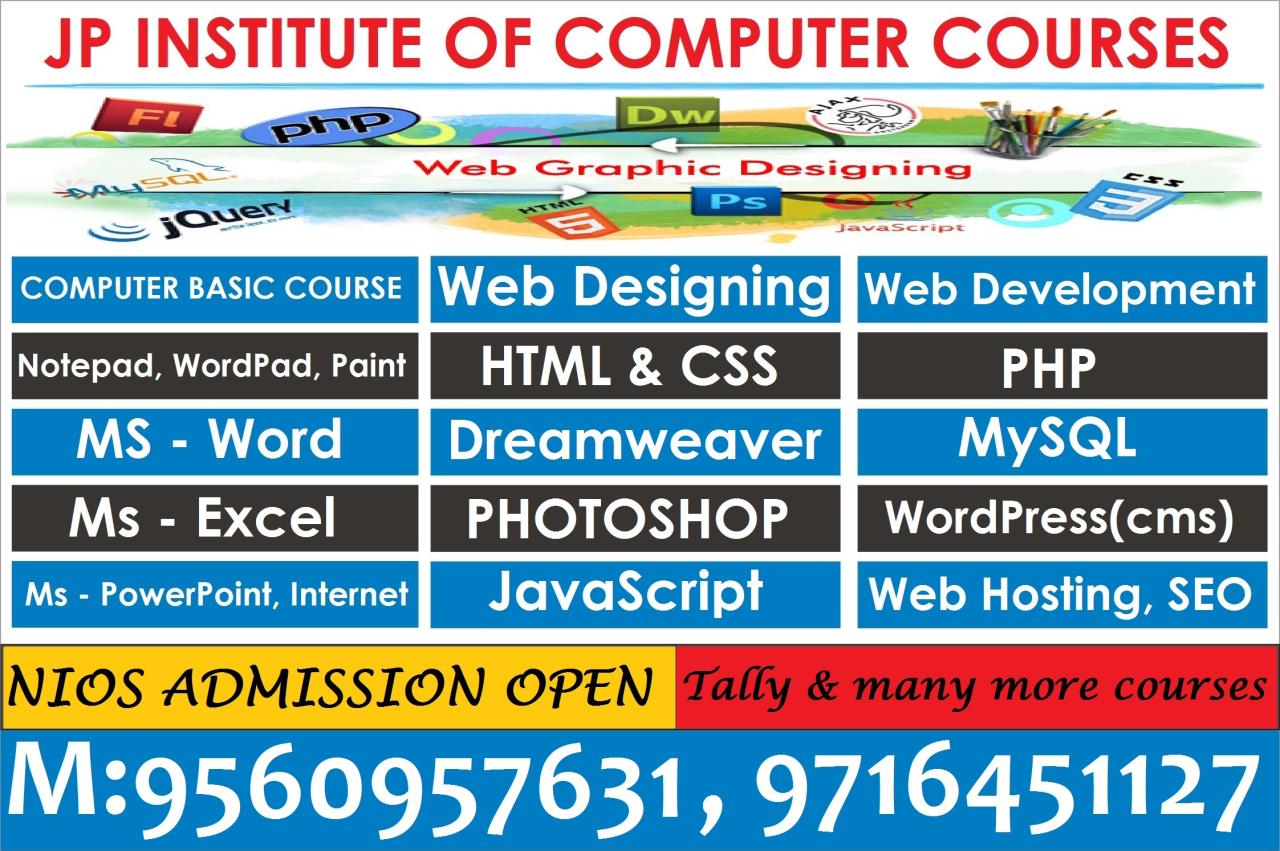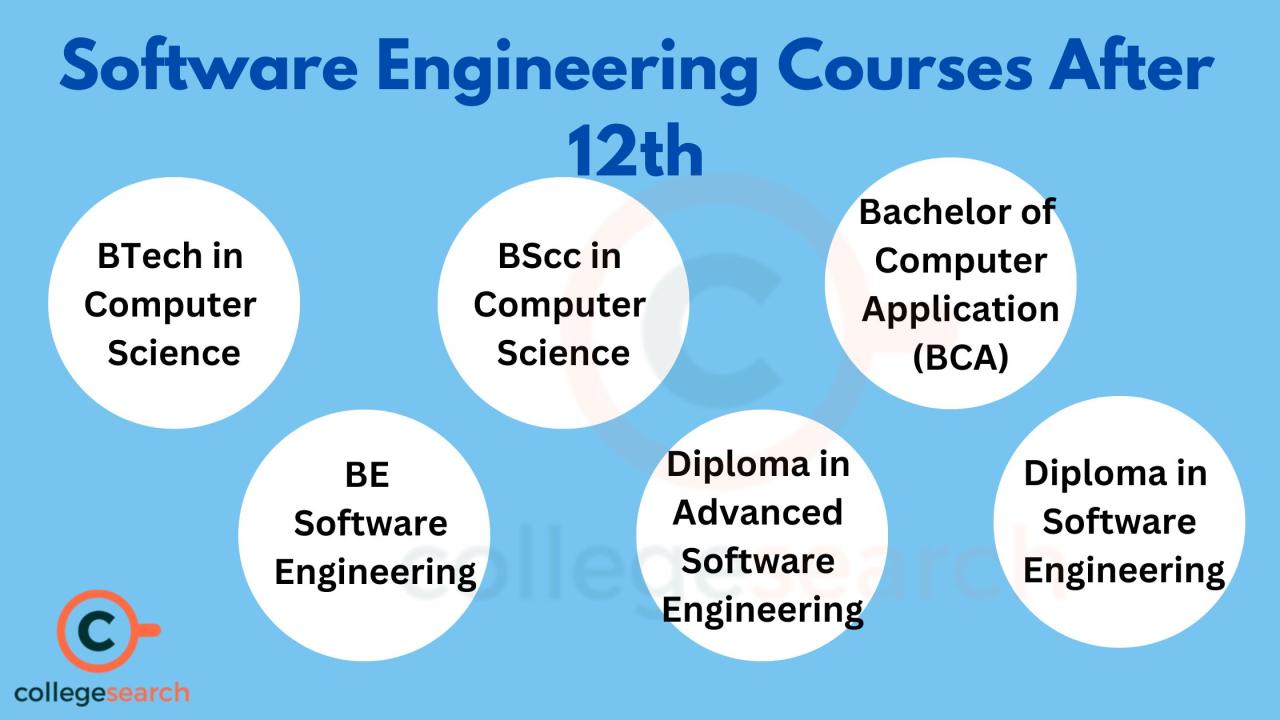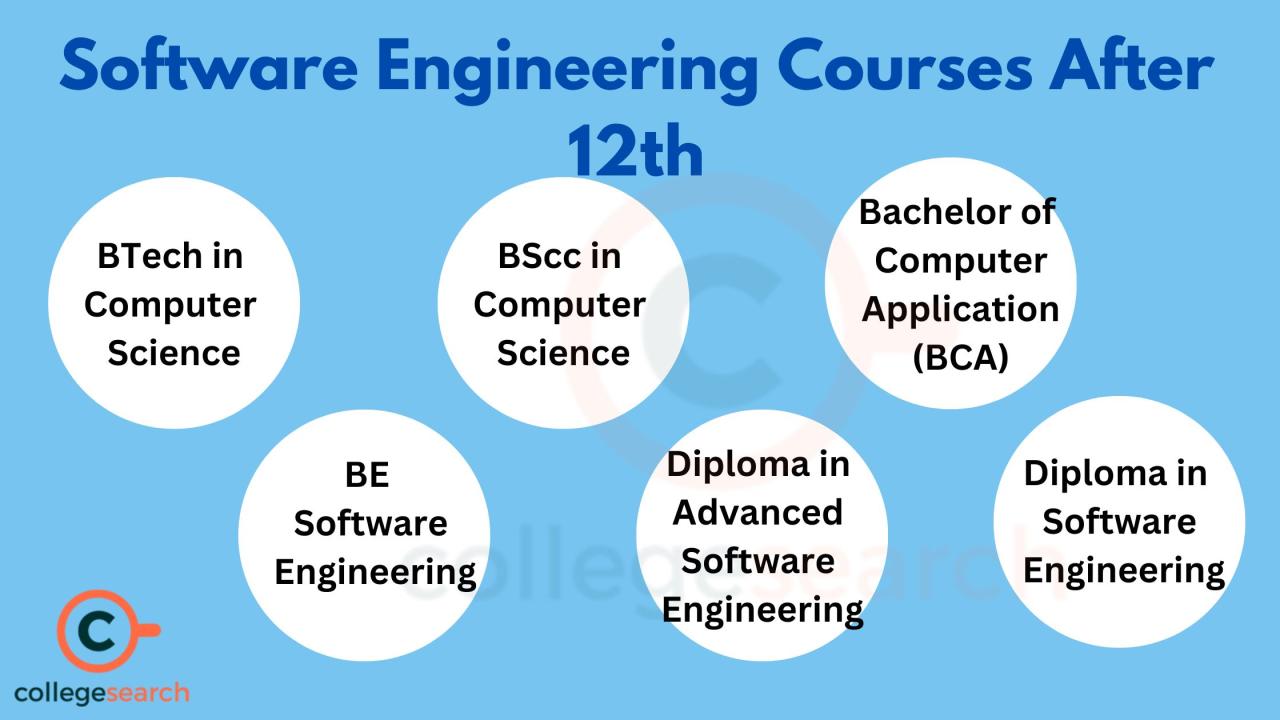IT Courses offer a gateway to exciting careers in technology. This guide explores various IT course types, delivery methods, costs, and how to choose the right path for your skills and goals. We’ll cover everything from in-demand skills to future trends, ensuring you’re well-prepared for a thriving tech career. Whether you’re a complete beginner or looking to upskill, we’ll help you navigate the world of IT training.
We’ll delve into the specifics of different IT course categories, comparing online and in-person learning, and analyzing the return on investment (ROI) for various programs. We’ll also discuss crucial soft skills and how to find the best courses and certifications to boost your career prospects.
Types of IT Courses
The IT field is vast, offering a wide array of courses catering to different interests and career goals. Choosing the right course depends on your existing skills, aspirations, and the specific area of IT you want to specialize in. Below is a categorized list of common IT course types, along with examples and typical skill acquisition.
Thinking about boosting your career with IT courses? Learning new skills is key, just like how Mohamed Salah is always striving for more. Check out this exclusive interview where he talks about wanting something “special”: Mohamed Salah exclusive: Liverpool forward wants ‘special. Similarly, investing in IT training can be your “special” something, giving you a competitive edge in the job market.
So, browse those IT courses and level up your future!
| Category | Course Name | Description | Typical Duration |
|---|---|---|---|
| Networking | CCNA (Cisco Certified Network Associate) | Covers fundamental networking concepts, including routing, switching, and network security. | 6-12 months |
| Cybersecurity | CompTIA Security+ | Focuses on foundational cybersecurity concepts, risk management, and security architecture. | 3-6 months |
| Software Development | Introduction to Java Programming | Teaches the basics of Java programming, including object-oriented programming and data structures. | 3-6 months |
| Data Science | Python for Data Analysis | Covers data manipulation, analysis, and visualization using Python libraries like Pandas and Matplotlib. | 3-6 months |
| Database Administration | SQL Fundamentals | Introduces fundamental SQL commands for database management and querying. | 2-4 months |
| Cloud Computing | AWS Certified Cloud Practitioner | Provides a foundational understanding of AWS cloud services and their applications. | 2-4 months |
| Web Development | Full Stack Web Development Bootcamp | Covers front-end (HTML, CSS, JavaScript) and back-end (server-side languages, databases) development. | 6-12 months |
Skills gained vary widely depending on the course. Networking courses develop skills in network design, troubleshooting, and security. Cybersecurity courses build expertise in risk assessment, incident response, and security protocols. Software development courses equip students with programming skills, while data science courses enhance analytical and visualization abilities. Database administration courses focus on data management and querying, and cloud computing courses provide expertise in cloud services and architectures.
So you’re thinking about IT courses? Picking the right one can be tricky, but understanding the impact of lifestyle choices is important too. Check out this article on a serious health issue: Putting a cancer warning on alcohol is overdue, doctors say , it highlights the need for informed decisions. This kind of awareness can help you make healthier choices alongside your IT career goals.
Web development courses cultivate skills in both front-end and back-end development, encompassing design, functionality, and user experience.
IT Course Delivery Methods
IT courses are offered through various methods, each with its own advantages and disadvantages. The ideal choice depends on individual learning styles, schedules, and preferences.
Here’s a comparison of common delivery methods:
- Online Courses:
- Advantages: Flexibility, accessibility, affordability (often).
- Disadvantages: Requires self-discipline, less direct interaction with instructors and peers.
- Ideal Learning Environment: Quiet, dedicated workspace with reliable internet access.
- In-Person Courses:
- Advantages: Direct interaction with instructors and peers, structured learning environment, immediate feedback.
- Disadvantages: Less flexible scheduling, geographical limitations, potentially higher cost.
- Ideal Learning Environment: Classroom setting with comfortable seating, access to resources, and opportunities for collaboration.
- Hybrid Courses:
- Advantages: Combines the flexibility of online learning with the structure and interaction of in-person learning.
- Disadvantages: Requires a balance of online and in-person participation, may not be suitable for all learning styles.
- Ideal Learning Environment: A blend of online and physical spaces, allowing for both independent study and collaborative sessions.
- Self-Paced Courses:
- Advantages: Complete control over the learning pace, flexibility to adjust the schedule.
- Disadvantages: Requires strong self-motivation and time management skills, limited instructor support.
- Ideal Learning Environment: A structured workspace with minimal distractions, allowing for focused and independent study.
Cost and Return on Investment (ROI) of IT Courses

The cost of IT courses varies significantly based on factors like course length, institution type, and level of instruction. Bootcamps can range from $10,000 to $20,000, while university degrees can cost considerably more. However, the potential return on investment (ROI) can be substantial, considering the high demand and competitive salaries in the IT industry.
Potential career paths and salary expectations after completing various IT courses:
- Cybersecurity Analyst: $100,000 – $150,000 per year
- Software Developer: $80,000 – $120,000 per year
- Data Scientist: $90,000 – $140,000 per year
- Network Engineer: $70,000 – $110,000 per year
| Course | Initial Investment | Average Annual Salary (5 years post-graduation) | ROI (5 years) |
|---|---|---|---|
| Cybersecurity Bootcamp | $15,000 | $120,000 | Significant positive ROI |
| Software Development Bootcamp | $12,000 | $95,000 | Significant positive ROI |
| Data Science Bootcamp | $18,000 | $110,000 | Significant positive ROI |
Note: These salary figures are estimates and can vary based on experience, location, and employer. ROI calculations are simplified and do not account for all factors.
Choosing the Right IT Course
Selecting the right IT course requires careful consideration of various factors. A systematic approach ensures you choose a program aligned with your goals and capabilities.
- Assess your interests and skills: Identify areas within IT that genuinely excite you and leverage your existing strengths.
- Define your career goals: Determine the specific IT role you aspire to achieve. This will guide your course selection.
- Research different courses: Explore course curricula, instructor qualifications, and student reviews.
- Check accreditation and reputation: Ensure the institution and course are reputable and recognized by industry employers.
- Consider the learning format: Choose a delivery method that aligns with your learning style and schedule.
- Evaluate the cost and ROI: Weigh the financial investment against potential future earnings.
- Network with IT professionals: Seek advice and insights from individuals working in your target field.
Essential Skills for IT Professionals

Success in the IT industry requires a blend of technical and soft skills. While technical skills provide the foundational knowledge, soft skills are crucial for effective collaboration and problem-solving.
In-demand technical skills:
- Programming (Python, Java, C++, JavaScript)
- Networking (TCP/IP, routing, switching)
- Cybersecurity (ethical hacking, penetration testing)
- Database management (SQL, NoSQL)
- Cloud computing (AWS, Azure, GCP)
Important soft skills:
- Communication (written and verbal)
- Teamwork and collaboration
- Problem-solving and critical thinking
- Adaptability and continuous learning
Many IT courses integrate the development of these soft skills through group projects, presentations, and real-world case studies.
Thinking about boosting your career with IT courses? Knowing the salary potential can be motivating! Check out how much Canada’s top earners make, like those featured in this article: Who are Canada’s top-earning CEOs and how much do they make? This can give you a sense of the high-end earning potential in tech, and fuel your desire to invest in the right IT courses to reach your goals.
Future Trends in IT and Relevant Courses
The IT landscape is constantly evolving, with emerging technologies shaping future job roles. Staying ahead of the curve requires continuous learning and adaptation.
Emerging technologies and their impact:
- Artificial Intelligence (AI): Driving automation and data analysis, creating demand for AI specialists.
- Machine Learning (ML): Enabling predictive modeling and intelligent systems, requiring expertise in ML algorithms and frameworks.
- Blockchain Technology: Revolutionizing data security and transparency, necessitating understanding of blockchain principles and development.
- Internet of Things (IoT): Connecting devices and creating vast networks of data, requiring skills in IoT device management and security.
Future-proof IT skills and relevant courses:
- AI/ML: Courses in machine learning, deep learning, and AI ethics.
- Blockchain: Courses on blockchain development, cryptography, and decentralized applications.
- Cloud Security: Courses specializing in cloud security architecture, cloud-native security, and cloud forensics.
- Data Analytics: Courses in big data analytics, data visualization, and data mining.
IT Course Certification and Accreditation
IT certifications validate your skills and knowledge, enhancing your career prospects. Reputable certifications demonstrate competence and professionalism to potential employers.
| Certification | Awarding Body | Job Roles |
|---|---|---|
| CompTIA A+ | CompTIA | Help Desk Technician, IT Support Specialist |
| CompTIA Network+ | CompTIA | Network Administrator, Network Engineer |
| AWS Certified Solutions Architect | Amazon Web Services | Cloud Architect, Cloud Engineer |
| Microsoft Certified: Azure Administrator Associate | Microsoft | Azure Administrator, Cloud Engineer |
Resources for Finding IT Courses

Numerous platforms offer IT courses, each with its own strengths and weaknesses. Choosing the right platform depends on your learning style, budget, and course preferences.
| Platform | Course Selection | Cost | Learning Style Support |
|---|---|---|---|
| Coursera | Wide range of courses from universities and organizations | Varies, from free to paid | Video lectures, quizzes, assignments |
| edX | Similar to Coursera, offering courses from top universities | Varies, from free to paid | Video lectures, interactive exercises, peer review |
| Udemy | Large selection of IT courses, many from independent instructors | Varies, often discounted | Video lectures, downloadable resources |
| Udacity | Focuses on nanodegrees and more intensive programs | Generally more expensive | Project-based learning, mentorship |
Closing Summary
Choosing the right IT course is a significant step towards a rewarding tech career. By carefully considering your interests, career aspirations, and the evolving landscape of technology, you can confidently select a program that aligns with your goals. Remember to factor in cost, delivery method, and accreditation when making your decision. With dedication and the right training, a successful future in IT is within your reach.
User Queries
What is the average salary for IT professionals after completing a course?
Salaries vary greatly depending on the specific course, role, and experience. Entry-level positions can range from $50,000 to $80,000 annually, while experienced professionals can earn significantly more.
How long do most IT courses take to complete?
Course duration varies widely, from short certificate programs lasting a few weeks to intensive degree programs taking several years. Consider your time commitment and learning style when choosing a program length.
Are there scholarships or financial aid options for IT courses?
Many institutions offer scholarships, grants, and financial aid programs for IT courses. Check with the specific schools or online platforms you’re considering for available options.
What if I don’t have a background in technology? Can I still take IT courses?
Absolutely! Many IT courses are designed for beginners with no prior experience. Start with introductory courses and gradually build your skills.
